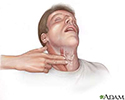Vital signs
Vital signs reflect essential body functions, including your heartbeat, breathing rate, temperature, and blood pressure. Your health care provider may watch, measure, or monitor your vital signs to check your level of physical functioning.
Normal vital signs change with age, sex, weight, exercise capability, and overall health.
Normal vital sign ranges for the average healthy adult while resting are:
- Blood pressure: 90/60 mm/Hg to 120/80 mm/Hg
- Breathing: 12 to 18 breaths per minute
- Pulse: 60 to 100 beats per minute
- Temperature: 97.8°F to 99.1°F (36.5°C to 37.3°C)/average 98.6°F (37°C)
References
Simel DL. Approach to the patient: history and physical examination. In: Goldman L, Schafer AI, eds. Goldman's Cecil Medicine . 24th ed. Philadelphia, PA: Elsevier Saunders; 2011:chap 6.
-
Neck pulse - illustration
To measure the pulse on the neck, place the index and middle finger just to the side of the Adam's apple, in the soft hollow area. This pulse is felt in the common carotid artery.
Neck pulse
illustration
Review Date: 1/31/2015
Reviewed By: Linda J. Vorvick, MD, Medical Director and Director of Didactic Curriculum, MEDEX Northwest Division of Physician Assistant Studies, Department of Family Medicine, UW Medicine, School of Medicine, University of Washington, Seattle, WA. Also reviewed by David Zieve, MD, MHA, Isla Ogilvie, PhD, and the A.D.A.M. Editorial team.

